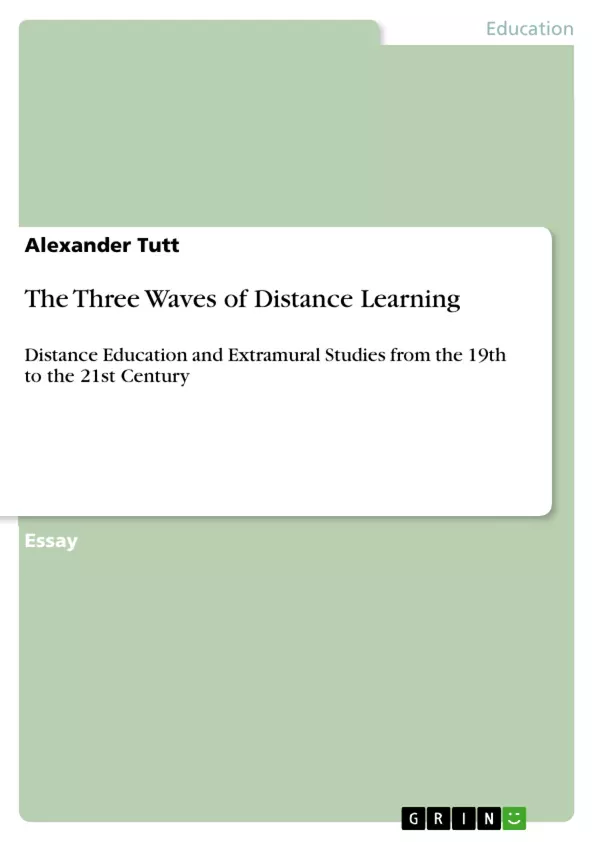Apart from health and income, the subject matter of education serves as one of the principal indicators for modern social science. The internationalization of higher education is directly connected to the evolution and revolution of interconnectivity. This essay seeks to examine the development of different distance learning practices from the nineteenth century until present day. The terminology of the matter is to some extent irregular, wherefore the defining of semantics is part of this essay, too. As it can be derived from the title, at least three definitional terms are involved: distance learning, distance education and extramural studies. In order to shed light on these terms, similar developments in different contexts have to be taken into account. Therefore, it is impossible to give conclusive definitions already at the beginning. Rather, this essay follows the method of process tracing, outlining ‘three waves’ of distance learning. As a consequence, this essay is structured in a threefold manner: First of all, the ‘first wave’ of distance learning is introduced, giving first definitions of the term and outlining first proceedings in the active acquisition of education over long-distances in the nineteenth century. Afterwards, demarcating the ‘second wave’, the view is turned to distance education in the twentieth century, featured by a rapid advance of electronic media. Lastly, a picture of today’s distance-learning infrastructure is drawn, paying special attention to the accelerated progress of internet-based teaching and learning. Throughout the examination of the topic, aspects of power transition and diffusion are problematized.
Inhaltsverzeichnis (Table of Contents)
- Pioneers of distance learning: the first wave
- Distance learning in the 20th century: the second wave
- Distance learning in the 21st century: the third wave
- Future prospects
Zielsetzung und Themenschwerpunkte (Objectives and Key Themes)
This essay aims to examine the evolution of distance learning practices from the 19th century to the present day. It will delve into the development of different approaches, from early correspondence courses to contemporary internet-based teaching and learning. The essay will also explore the changing nature of power dynamics in education, specifically focusing on the transition and diffusion of knowledge.
- The historical development of distance learning, categorized into three distinct "waves."
- The emergence of key institutions and pioneers in distance education, such as the Sir Isaac Pitman Correspondence College, the Chatauqua Literary and Scientific Circle, and the British Open University.
- The influence of technological advancements, such as the development of postal services, radio broadcasting, television, and the internet, on distance learning practices.
- The shifting dynamics of power in education, particularly the transition and diffusion of knowledge from public to private spheres.
- The challenges and opportunities presented by distance learning in the 21st century, such as the "digital generation gap" and the need for universities to adapt to new technologies.
Zusammenfassung der Kapitel (Chapter Summaries)
This essay examines the development of distance learning from the 19th century to the present day, dividing it into three "waves." The first wave examines the early days of distance learning, focusing on the pioneering correspondence courses established in the 19th century. The second wave focuses on the rise of distance education in the 20th century, characterized by the emergence of radio and television broadcasting as educational tools. Finally, the third wave delves into the current era of internet-based distance learning, exploring the impact of the internet and the rise of online universities.
Schlüsselwörter (Keywords)
This essay primarily explores the concepts of distance learning, distance education, extramural studies, power transition, power diffusion, and the influence of technological advancements on educational practices. It also examines the changing dynamics of power in education, particularly in relation to the evolution of distance learning.
- Quote paper
- Alexander Tutt (Author), 2013, The Three Waves of Distance Learning, Munich, GRIN Verlag, https://www.grin.com/document/275402



